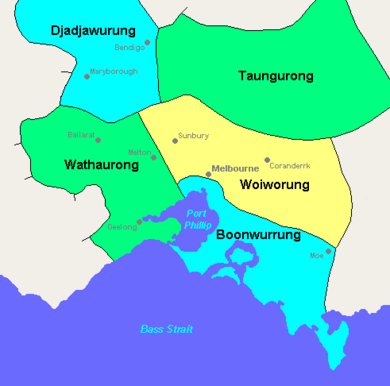Kulin nation facts for kids
The Kulin nation is an alliance of five Aboriginal nations in southern Australia. They live in areas stretching into the Great Dividing Range and the Loddon and Goulburn River valleys. These nations share a common culture and language.
History of the Kulin Nation
Before British people arrived, the tribes of the Kulin nation spoke five related languages. These languages belonged to two main groups. The eastern group included Woiwurrung–Taungurung, Boonwurrung, and Ngurai-illam-wurrung. The western group had just one language: Wadawurrung.
People have lived in central Victoria for a very long time, possibly as far back as 42,000 years ago. When British settlers arrived in the 1830s, there were likely fewer than 20,000 people in the Woiwurrung, Boonwurrung, and Wadawurrung tribes.
The Kulin people lived by fishing and cultivating plants like murnong (also called yam daisy). They also lived by hunting and gathering food. They used the rich food sources from Port Phillip Bay and the surrounding grasslands in a way that protected the environment for future generations.
Because of the big changes and problems caused by British settlement from the 1830s onwards, there is not much physical evidence left of the Kulin peoples' shared past. However, a few important cultural and spiritual sites still exist in the Melbourne area.
People of the Kulin Nation
The Kulin nation is made up of five main groups:
- Woiwurrung (Woy-wur-rung) – also known as the Wurundjeri people.
- Boonwurrung – the Boonwurrung people.
- Wathaurong (Wath-er-rung) – the Wathaurong people.
- Taungurung (Tung-ger-rung) – the Taungurung people.
- Dja Dja Wurrung (Jar-Jar-Wur-rung) – also known as the Djadjawurrung or Djaara people.
At certain times of the year, these nations would gather at Yarra Falls. They would meet to solve disagreements, trade goods, and hold special ceremonies called corroborees.
Diplomacy and Welcome Ceremonies
When people from other areas visited or were invited onto tribal lands, a special ceremony called tanderrum was performed. This ceremony was also known as "freedom of the bush." Its purpose was to allow visitors to travel safely and temporarily use the land and its resources. It was a diplomatic event where the landholders showed hospitality and exchanged gifts with their guests.


